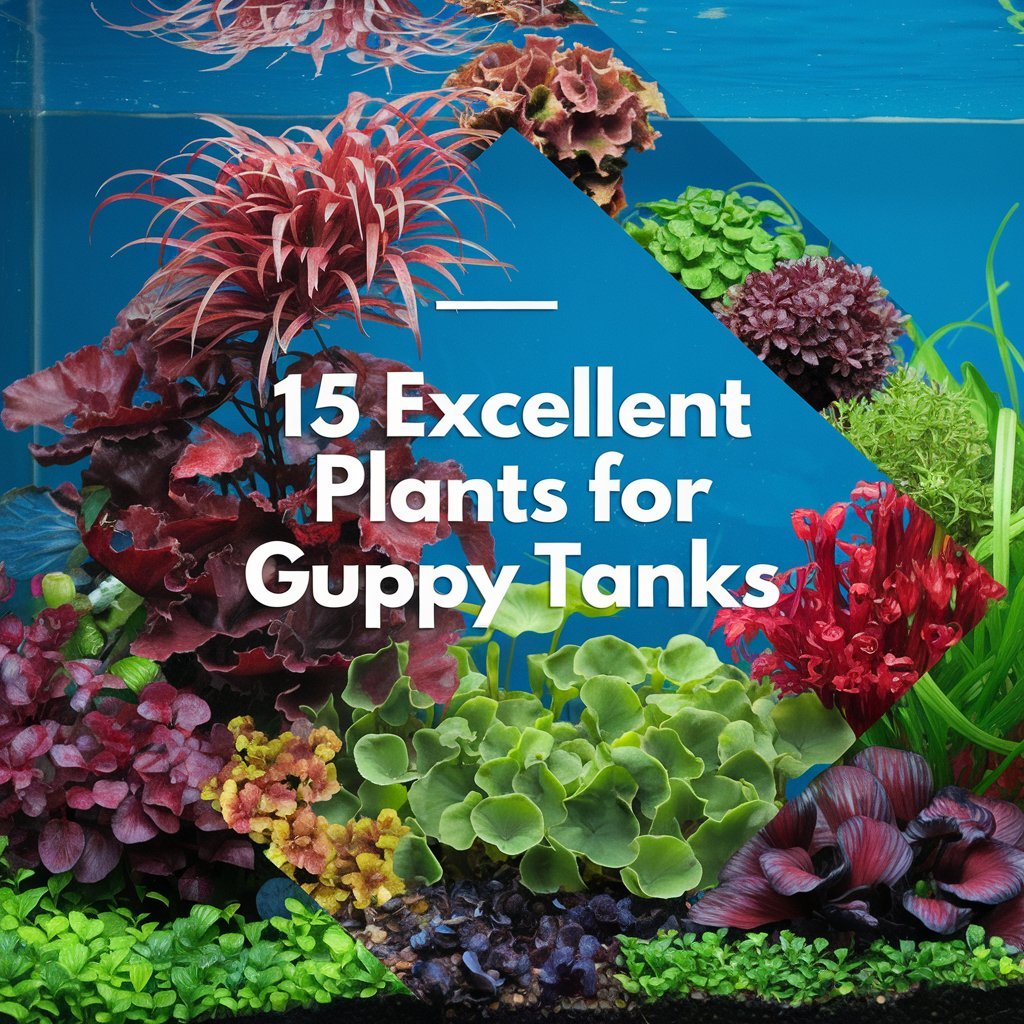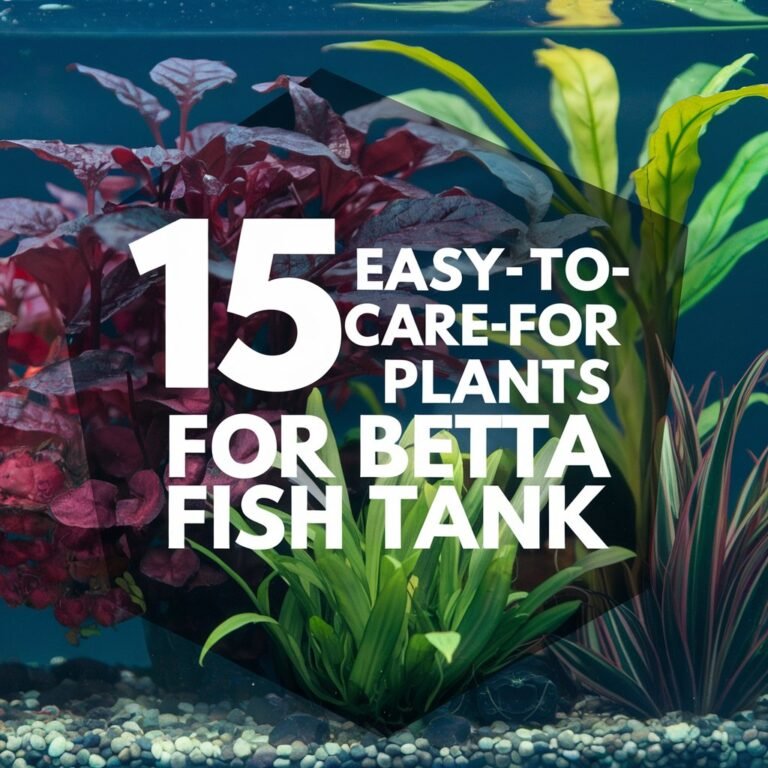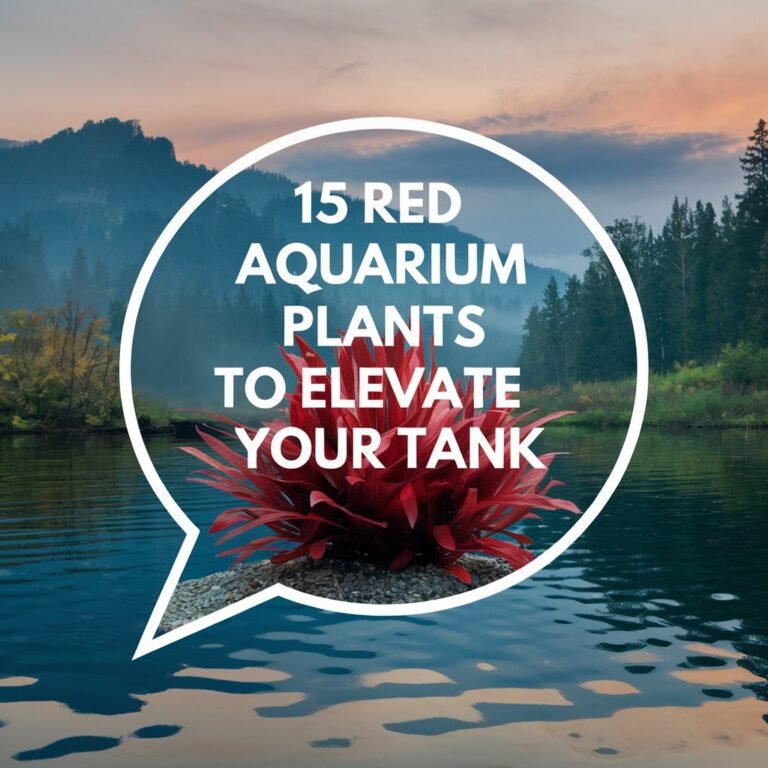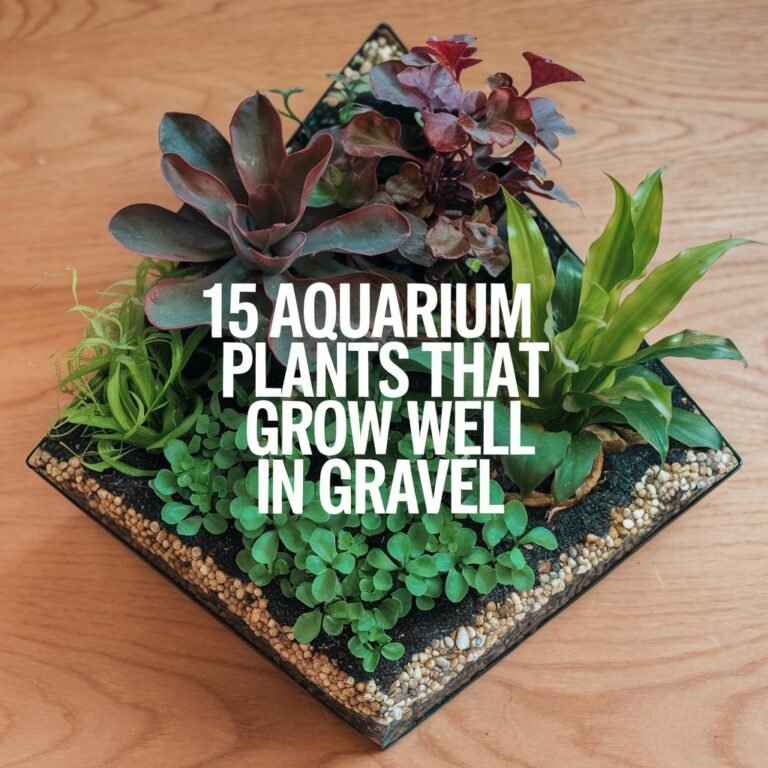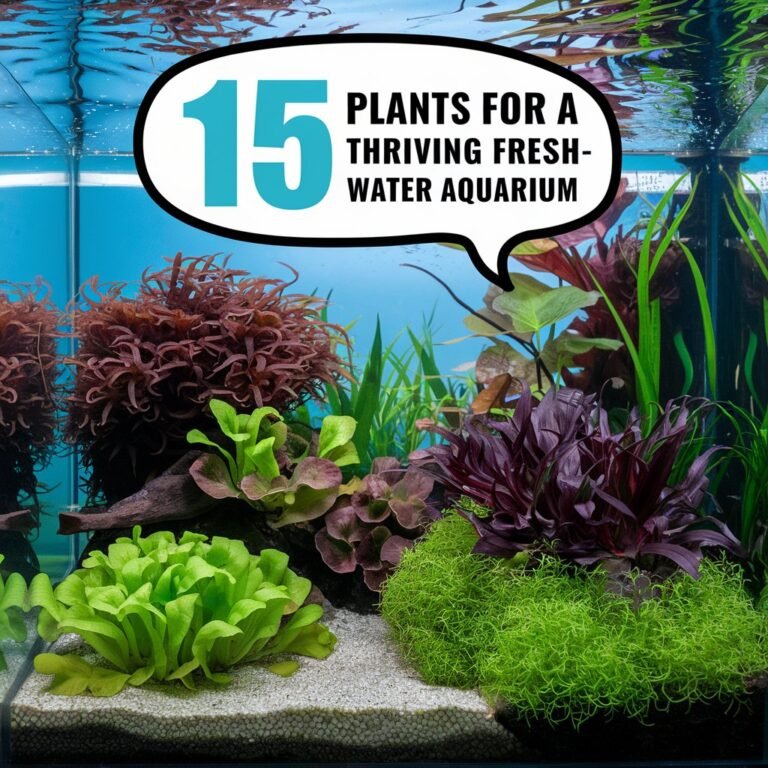15 Excellent Plants for Guppy Tanks to Keep Them Healthy
When setting up a thriving guppy tank, you’re probably aware of the importance of incorporating live plants. Not only do they add visual appeal, but they also help maintain a healthy environment for your guppies by controlling algae and improving water quality.
But with so many plant options available, it can be challenging to choose the best ones for your tank. You want plants that are easy to care for, provide shelter and food for your guppies, and complement their vibrant colors. So, which plants should you consider, and how can you guarantee they flourish in your guppy tank?
In A Nutshell
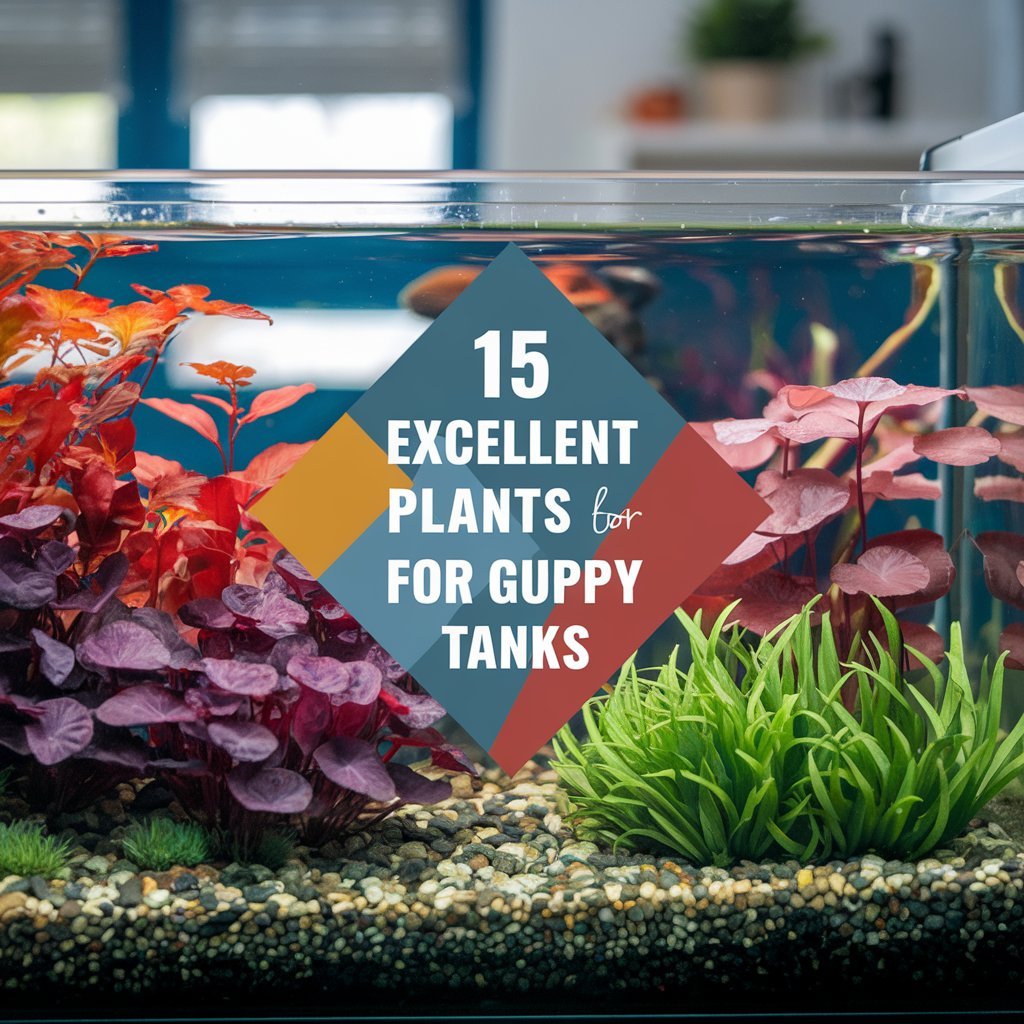
- Anacharis and Water Wisteria control algae and promote a healthy guppy environment by competing for nutrients and absorbing excess nitrates.
- Low-maintenance plants like Java Moss and Anubias Plants create hiding places for guppies and help maintain water quality with minimal pruning.
- Amazon Sword Plant, Cryptocoryne Plants, and Aponogeton Plant require specific temperature, pH, and lighting conditions for optimal growth and propagation.
- Live Watercress and other nutrient-rich plants like Watercress provide essential vitamins and phytonutrients for guppies, promoting their health and well-being.
- Easy-to-care-for plants like Hornwort, Water Sprite, and Nymphoides Plant provide shelter, food, and ideal water conditions for guppies to thrive.
Anacharis for Effective Algae Control
Anacharis, a fast-growing aquatic plant, is an excellent choice for controlling algae in guppy tanks.
When it comes to algae prevention methods, you’ll find that Anacharis is highly effective in keeping your tank clean. This plant grows rapidly and can be easily trimmed to maintain the desired length, making it a great option for aquatic habitat design.
In a guppy tank, Anacharis helps to prevent algae growth by competing for nutrients and absorbing excess nitrates.
It also provides a natural food source for your guppies, helping to keep them healthy and thriving. When designing your tank, consider incorporating Anacharis as a mid-water or background plant to create a natural environment for your guppies.
To keep your Anacharis plant healthy, guarantee it receives adequate lighting and maintain a water temperature between 72-82°F (22-28°C).
Regular water changes will also help to prevent the buildup of toxins and keep your plant thriving. By incorporating Anacharis into your tank, you’ll be able to create a balanced and healthy environment for your guppies to flourish.
Java Moss Plant for Guppies
If you’re looking to create a natural environment for your guppies that also promotes their health and well-being, consider adding Java Moss to your tank.
This low-maintenance plant is ideal for beginners and can thrive in a variety of lighting conditions, making it perfect for guppy tanks. Java Moss grows by attaching itself to rocks or driftwood, creating a natural hiding place for your guppies.
To keep your Java Moss healthy, regular cleaning is essential.
You should perform Moss cleaning at least once a week by gently agitating the moss with a soft-bristled brush to remove any debris that may have accumulated. This will also help to prevent the growth of algae.
Java Moss propagation is relatively straightforward.
Simply cut a section of the moss, and attach it to a new surface using a fishing line or a plant clip. Over time, the moss will grow and spread, creating a lush, natural environment for your guppies.
With proper care and maintenance, Java Moss can be a valuable addition to your guppy tank, providing a natural and healthy environment for your fish to thrive.
Amazon Sword Plant Care
Several Amazon Sword plants can thrive in a guppy tank, provided you offer them the right conditions.
These plants require a well-lit environment with moderate to high lighting, ideally 2-4 watts per gallon. You’ll also need to maintain a temperature range of 72-82°F (22-28°C) and pH levels between 6.5-7.5.
When it comes to Sword plant propagation, you can easily divide the plant’s rhizome to create new plants.
Simply cut the rhizome into sections, making sure each section has at least one growing point. Then, plant the sections in the substrate, and secure them with a rock or a plant weight.
To promote healthy growth, you’ll need to provide your Amazon Sword plants with essential nutrients through aquatic plant fertilization.
Use a balanced fertilizer that contains nitrogen, phosphorus, and potassium. You can also add micronutrients like iron and magnesium to support the plant’s growth. Regularly monitor the plant’s condition, and adjust the fertilization accordingly.
Water Wisteria Plant Benefits
When you’re setting up a guppy tank, choosing the right plants can greatly enhance its aesthetic appeal and overall health.
Water wisteria (Hygrophila difformis) is a popular aquatic plant that offers numerous benefits for your tank.
One of its primary advantages is its ability to provide shelter and hiding places for your guppies, reducing stress and promoting a sense of security.
Water wisteria growth is relatively fast, allowing it to quickly establish itself in your tank.
It can thrive in a variety of lighting conditions, from low to high, making it a versatile choice for different tank setups.
Water wisteria propagation is also straightforward, as it can be easily trimmed and replanted to maintain its desired shape and promote healthy growth.
Guppy Friendly Cryptocoryne Plants
You’re likely familiar with the versatility of Cryptocoryne plants in aquariums, but not all species are suitable for guppy tanks.
When choosing a Cryptocoryne species for your guppy tank, consider the water parameters and tank size. Cryptocoryne wendtii and Cryptocoryne beckettii are popular choices, as they’re relatively small and can thrive in low to moderate lighting conditions.
Cryptocoryne plants are known for their unique leaf shapes and colors, adding visual interest to your tank.
They’re also great for creating hiding places and providing shelter for your guppies. To propagate Cryptocoryne plants, you can divide the rhizome or separate the plantlets that form around the base of the mother plant.
This method of Cryptocoryne propagation allows you to easily share plants with fellow aquarists or expand your own collection.
When planting Cryptocoryne species in your guppy tank, make sure to bury the rhizome in the substrate and leave the leaves exposed.
This will help prevent the plant from uprooting and guarantee healthy growth. With proper care and attention, Cryptocoryne plants can be a beautiful and beneficial addition to your guppy tank.
Low Maintenance Anubias Plants
Anubias plants offer a low-maintenance alternative to Cryptocoryne species, making them an attractive option for guppy tank owners who want to add some greenery without the fuss.
They’re relatively easy to care for, requiring minimal pruning and tolerating low light conditions, making them ideal for guppy tanks with limited lighting. Anubias care involves regular water changes, maintaining pH levels between 6.5-8, and temperatures between 72-82°F.
These plants thrive in a nutrient-rich substrate and can be attached to rocks or driftwood.
When choosing Anubias varieties, you’ll find several options suitable for guppy tanks.
Anubias barteri, Anubias coffeefolia, and Anubias nana are popular choices, each offering unique characteristics, such as varying leaf shapes and sizes. Anubias barteri is a compact variety, making it perfect for smaller tanks, while Anubias coffeefolia has longer, more delicate leaves.
Regardless of the variety, Anubias plants provide excellent hiding places for guppies and help maintain water quality by absorbing excess nutrients.
With proper Anubias care, these plants will thrive and add a natural, decorative touch to your guppy tank. They’re a great option for those who want to create a beautiful, low-maintenance aquarium.
Fast Growing Hornwort Plants
Hornwort plants are a fast-growing, floating option that can be added directly to your guppy tank, providing instant shelter and food for your fish.
They’re an excellent choice for guppy keepers, as they’re easy to care for and can thrive in a variety of conditions. Hornwort plants can be attached to a surface or left to float, allowing you to customize their placement in your tank.
When it comes to Hornwort propagation, you can easily multiply your plants by cutting them into smaller sections and allowing them to grow.
This process can be repeated every few weeks, providing you with a constant supply of new plants. Hornwort lighting requirements are relatively low, with plants able to thrive in low to moderate lighting conditions.
However, they’ll grow more quickly and densely with increased lighting. Aim for 1-2 watts per gallon of lighting to promote healthy growth.
Live Watercress for Guppies
Live watercress can be a nutritious and delicious addition to a guppy’s diet. This leafy green is rich in vitamins A, C, and K, as well as minerals like calcium and iron, making it an excellent supplement to their regular flake or pellet food.
To offer live watercress to your guppies, simply place a small bunch of the plant in the aquarium, securing it with a weight or clip if necessary.
The guppies will happily graze on the leaves, and you can replace the watercress every few days to keep it fresh. Not only will live watercress provide your guppies with a tasty treat, but it will also help to promote healthy digestion and support their overall well-being.
Water Sprite Plant Advantages
When choosing plants for your guppy tank, consider the versatile Water Sprite plant, which offers numerous advantages for both you and your aquatic pets.
This plant is relatively easy to care for, making it perfect for beginners. Water sprite care involves providing moderate to bright lighting, and maintaining a temperature range of 72-82°F (22-28°C).
It can thrive in a variety of water conditions, from soft to hard water, and pH levels between 6.0-8.0.
One of the significant advantages of the Water Sprite plant is its ability to provide shelter and food for your guppies.
The plant’s long, flowing stems and leaves create a natural hiding place for your fish, reducing stress and promoting a sense of security.
Additionally, the plant’s roots help to stabilize the substrate and prevent it from being disturbed by your guppies.
Water sprite propagation is also relatively easy, as it can be done by simply cutting the stems and replanting them in the substrate.
This allows you to easily propagate the plant and create a lush, thriving environment for your guppies.
Best Conditions for Cabomba
Cabomba offers another excellent option for guppy tanks, but this plant requires more specific conditions to thrive.
To keep your Cabomba healthy, you’ll need to maintain a temperature range of 72°F to 82°F (22°C to 28°C). It’s also vital to guarantee a pH level between 6.5 and 7.5, as this plant can’t tolerate extreme changes in water chemistry.
In terms of lighting, Cabomba prefers bright, indirect light.
You can achieve this by placing the plant near the surface of the water or using a high-quality aquarium light.
When it comes to water circulation, Cabomba requires moderate to strong currents to prevent the growth of algae.
For successful Cabomba care, you’ll need to fertilize the plant regularly, using a balanced fertilizer that contains essential nutrients like nitrogen, phosphorus, and potassium.
You can also propagate Cabomba using stem cuttings or by separating the plant’s rhizome.
Cabomba propagation methods involve cutting the stem just above a node and replanting it in the substrate.
Aponogeton Plant Care Essentials
Your Aponogeton plant requires a unique set of conditions to thrive in a guppy tank.
It’s vital to provide it with medium to high lighting, but guarantee the light isn’t too intense, as this can cause algae growth. Aim for Aponogeton lighting that’s around 2-3 watts per gallon, and maintain a photoperiod of 10-12 hours.
Maintain a temperature range of 72-82°F (22-28°C) and pH levels between 6.5-7.5.
Aponogeton plants are adaptable to various water conditions, but they prefer soft to moderately hard water.
Use a balanced fertilizer, and avoid over-fertilizing, as this can harm the plant.
Aponogeton propagation is relatively easy.
You can propagate it by separating the rhizome sections, making sure each section has at least one growing eye.
Plant the sections about 1-2 inches deep in the substrate, and verify they’re not buried too deeply.
With proper care, your Aponogeton plant will thrive and help create a healthy environment for your guppies.
Regular pruning will also promote healthy growth and prevent the plant from becoming too leggy.
Using Guppy Grass in Tanks
Using Guppy Grass in Tanks
By incorporating guppy grass into your aquarium, you’re providing a nutrient-rich, oxygen-filled environment that’s perfect for your guppies to thrive in.
Guppy grass is a type of aquatic plant that serves as a natural food source and shelter for your guppies. This plant helps to maintain ideal water quality by absorbing excess nutrients and toxins, consequently creating a healthier environment for your fish.
As guppy grass grows, it provides your guppies with ample hiding places, reducing stress and aggression.
This is especially important for guppies, as they’re naturally skittish and require places to hide and feel secure.
In addition to its shelter benefits, guppy grass also serves as a natural food supplement, providing your guppies with essential nutrients.
You can use guppy grass as a replacement for or in conjunction with commercial Guppy food supplements, depending on your aquarium’s specific needs.
Properly maintaining guppy grass requires regular trimming and pruning to prevent overgrowth and promote healthy growth.
Pogostemon Plant Selection Guide
While guppy grass offers numerous benefits for aquarium inhabitants, other aquatic plants like Pogostemon can further enhance the ecosystem.
As a guppy tank owner, you’re likely considering adding Pogostemon varieties to your setup. There are several types to choose from, including Pogostemon stellatus, Pogostemon erectus, and Pogostemon helferi. Each variety has unique characteristics, so thorough research is necessary to understand their specific needs and growth habits before making a selection.
When it comes to Pogostemon propagation, you’ll find it relatively straightforward.
Pogostemon plants can be propagated through stem cuttings or division. For stem cuttings, simply trim a healthy stem section, remove lower leaves, and plant it in your substrate. Make sure to provide sufficient light and nutrients for ideal growth.
Division involves separating the plant’s rhizome into sections, each with a few leaves and roots. Replant the sections, and they’ll quickly establish themselves.
Nymphoides Plant for Aquariums
For creating a well-rounded and balanced aquatic environment, you may also consider adding Nymphoides plants to your guppy tank.
Nymphoides plants, also known as water snowflakes or floating heart, offer numerous benefits for your aquarium. They provide shade, reduce algae growth, and create hiding places for your guppies.
These plants are relatively easy to care for and can thrive in a variety of water conditions.
When it comes to aquarium decor, Nymphoides plants are an excellent choice.
They’ve heart-shaped leaves that float on the surface of the water, adding a unique and attractive element to your tank. You can plant them in the mid-ground or background of your tank, and they can grow up to 6 inches tall.
Nymphoides plants also produce small white flowers that bloom above the water’s surface, adding a pop of color to your aquarium.
With proper care, Nymphoides plants can help create a thriving and balanced ecosystem in your guppy tank. By incorporating these plants into your aquarium decor, you can create a beautiful and healthy environment for your guppies to thrive.
Vallisneria Plant for Aquatic Life
As you consider the best plants for your guppy tank, Vallisneria plants offer another excellent option.
Vallisneria, commonly known as Val, is a versatile, fast-growing aquatic plant suitable for freshwater aquariums. It thrives in a wide range of water conditions and temperatures, making it an ideal choice for guppy tanks.
When introduced to your aquarium, Vallisneria plants will help maintain a stable aquatic ecosystem.
They absorb excess nutrients and waste, preventing the buildup of toxic substances. This, in turn, creates a healthier environment for your guppies. Val plants also provide hiding places and visual interest for your fish, reducing stress and promoting their well-being.
In terms of maintenance, Vallisneria plants are relatively easy to care for.
They can grow in low to moderate lighting conditions and require minimal pruning to keep them under control. This plant can grow up to 20 inches tall, but you can trim it back to maintain the desired height.
Frequently Asked Questions
Can Guppies Live With Plants That Require High Lighting?
You can keep guppies with plants requiring high lighting by supplementing with low light plants and using artificial lighting that simulates natural day-night cycles, ensuring a balanced environment for both guppies and plants to thrive.
How Often Should I Trim Plants in My Guppy Tank?
You’ll want to establish a regular trimming schedule to control plant overgrowth, which can lead to algae buildup and reduced water quality. Trim back overgrown stems every 1-2 weeks, depending on your plants’ growth rates and tank conditions.
Are All Aquatic Plants Safe for Guppies to Eat?
When introducing aquatic plants to your guppy tank, you’ll find some edible plants that are safe for them to eat, but beware of toxic varieties like Olea europaea and Ricinus communis, which can be hazardous.
Can I Grow Plants in a Guppy Tank Without a Heater?
You can grow plants in a guppy tank without a heater, but it’s vital to choose cold-water species, as tropical species require warmer temperatures to thrive, and guppies can tolerate cooler water temperatures.
How Long Does It Take for Plants to Establish in a Guppy Tank?
You’ll notice initial growth within 1-2 weeks after introducing plants to your guppy tank. However, it may take 4-6 weeks for plant adaptation to occur, allowing them to thrive and stabilize in their new environment.
FInal Verdict
You’ve now got the knowledge to choose the best plants for your guppy tank. By incorporating these excellent plants, you’ll create a thriving environment that controls algae and promotes healthy guppy growth.
From Anacharis to Vallisneria, each plant offers unique benefits, such as natural food sources, hiding places, and visual interest. With proper care, these plants will help maintain ideal water quality and create a stunning aquarium for your guppies to flourish.
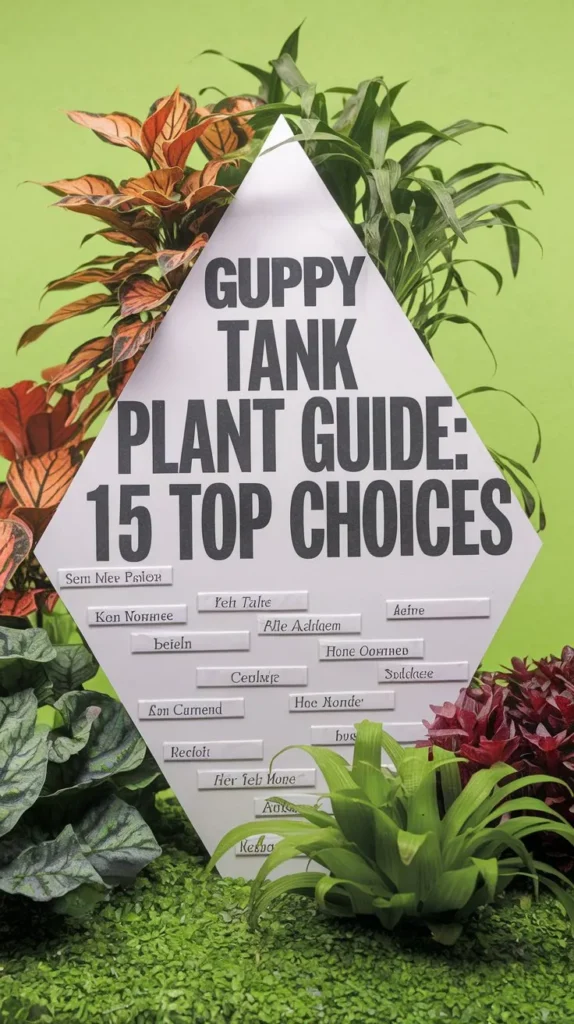
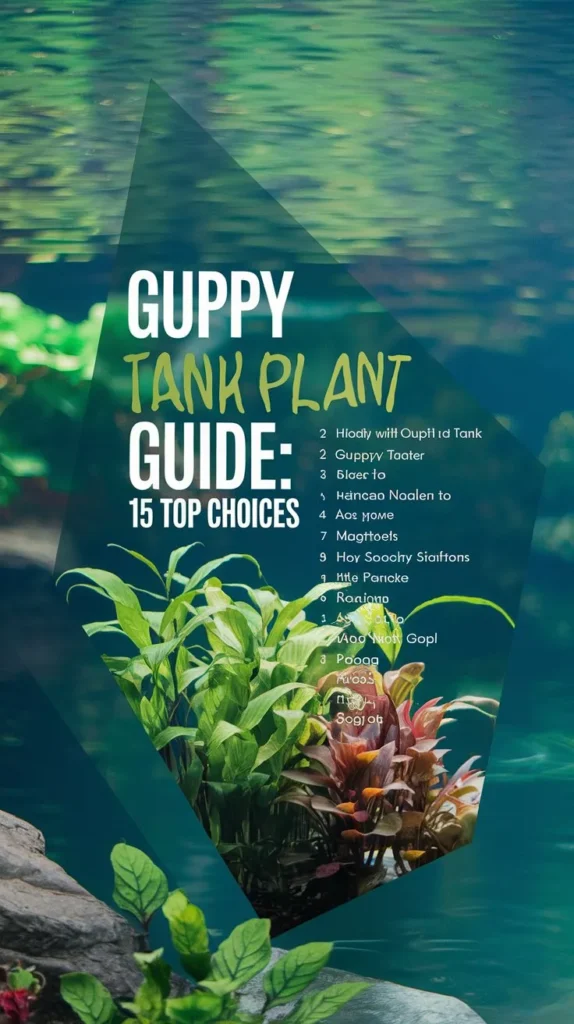
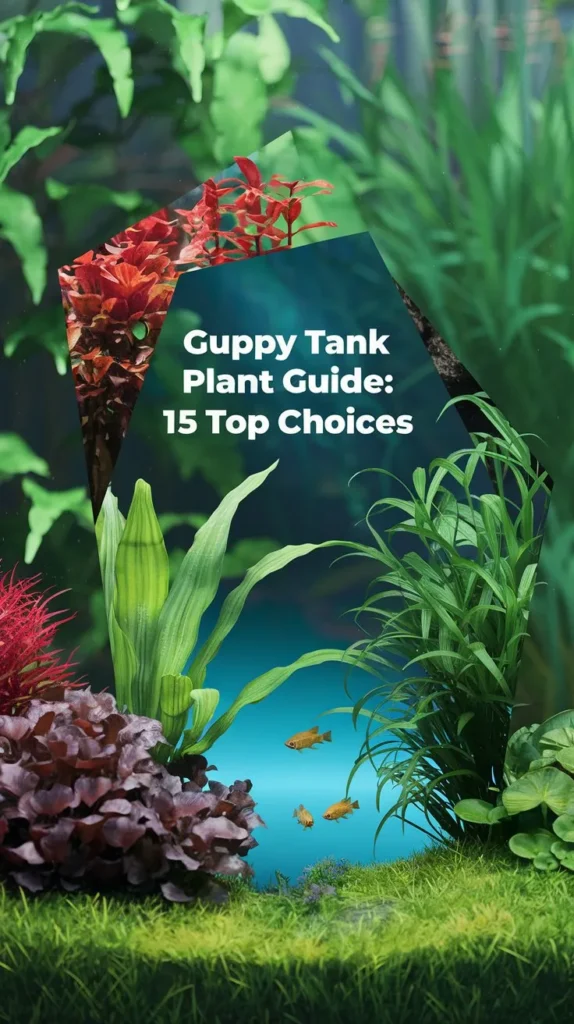
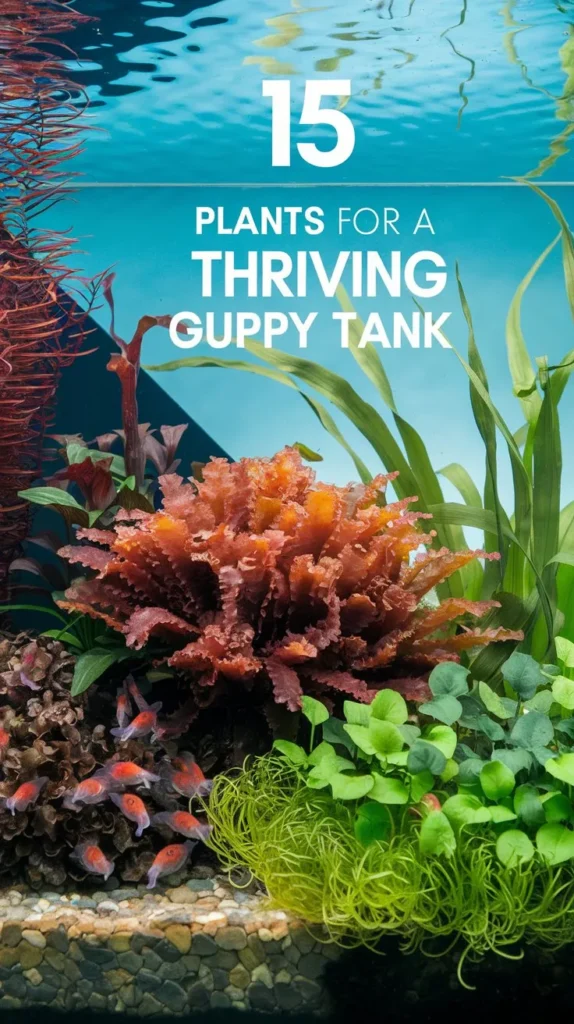
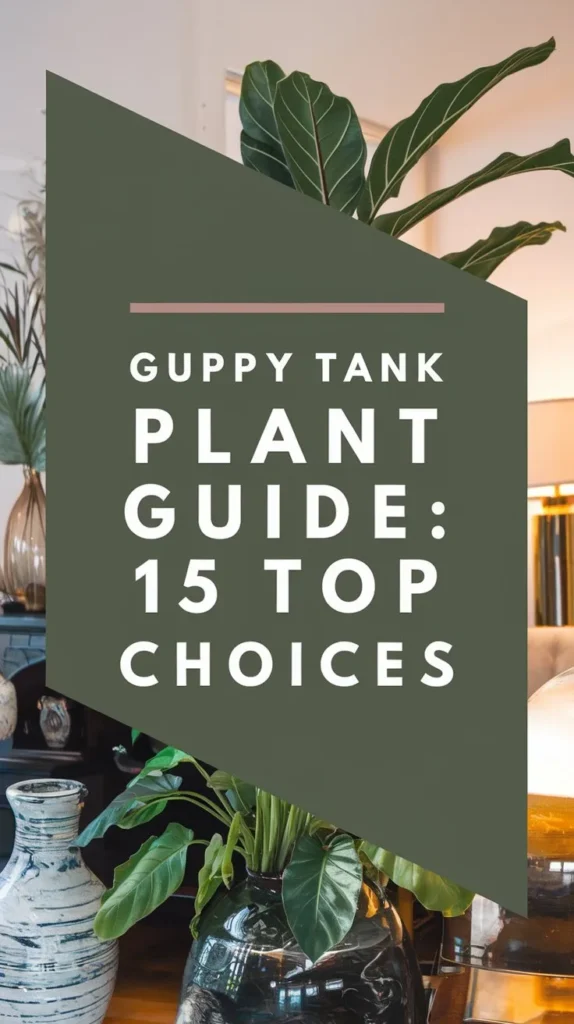

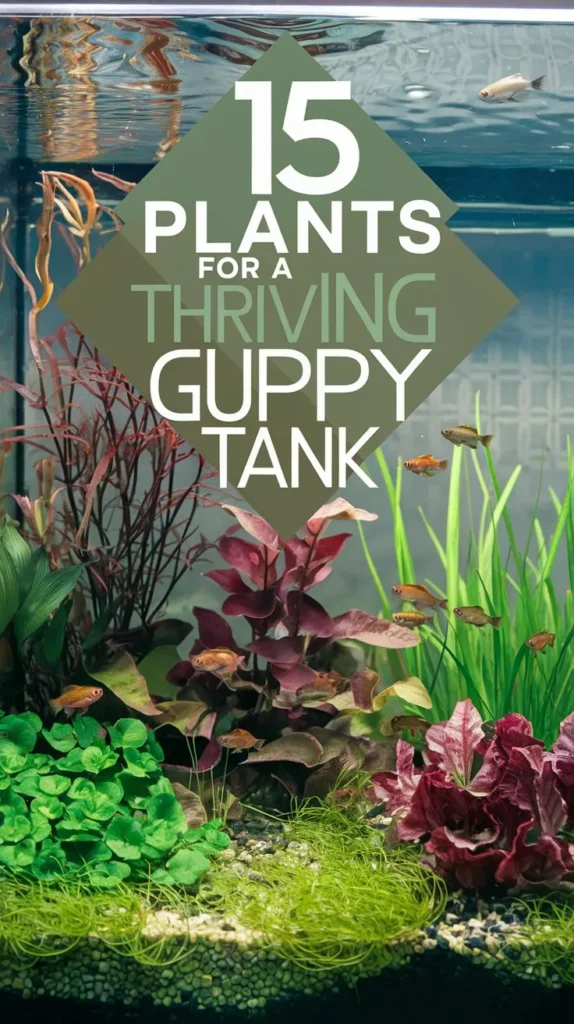
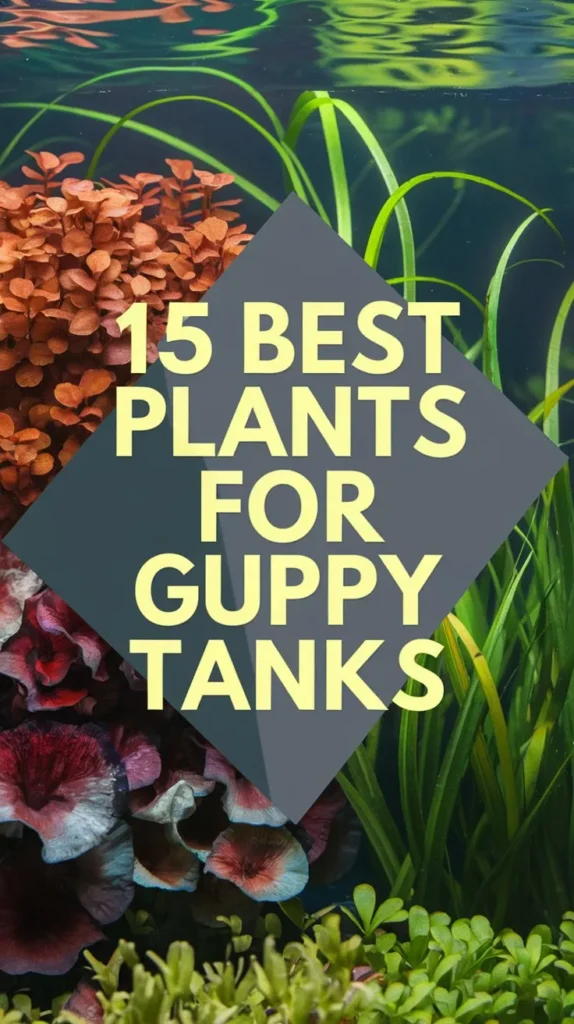


Hello, I’m Aria Cooper, the heart and soul behind Swimmy Buddies. As a devoted fish aficionado, I share my aquatic adventures and expertise to inspire your own underwater explorations. 🐠🌊

